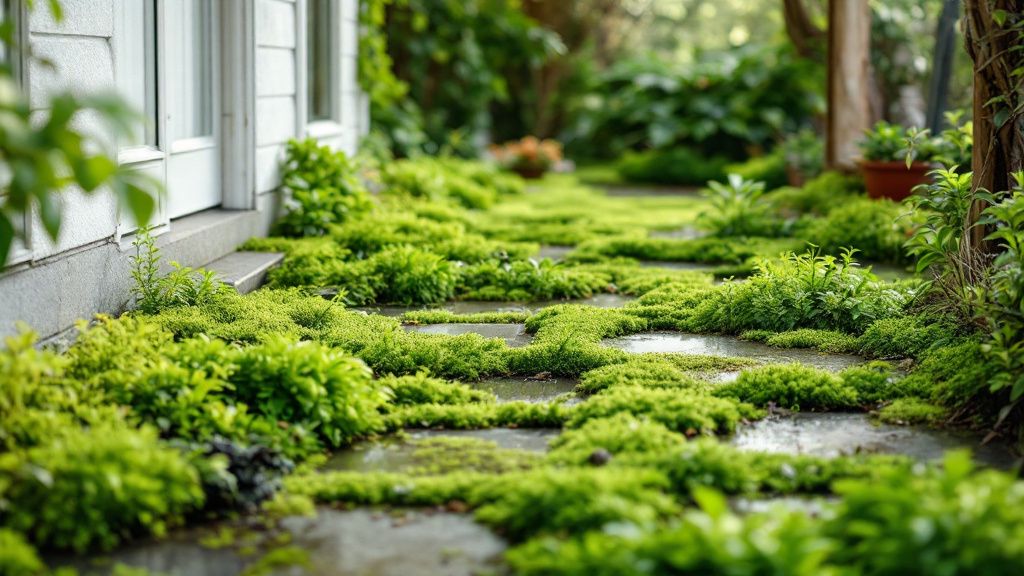To effectively keep moss out of your house, you need to understand its origins and manage moisture levels. Start by evaluating your home’s exterior, especially shaded or damp areas where moss tends to thrive. Regularly inspect your roof, walls, and walkways for signs of moss growth. Limit sunlight obstructions by trimming back trees and shrubs, which helps reduce the dampness that encourages moss in house.
For maintenance, employ moss cleaning solutions or pressure washing to remove any mosses on stubborn surfaces, offering a proactive moss removal approach. When considering how to clean moss, remember to use eco-friendly products that won’t harm your plants or the environment. If you’re uncertain about the best ways to get rid of moss on larger areas, consider moss cleaning services to efficiently tackle the problem. Lastly, prevent future growth by installing barriers like copper strips on roofs or using sealants on brick surfaces. Regular maintenance and preventive measures are key to staying moss-free.

Understanding Moss Growth in Humid Climates
Moss thrives in humid climates because such environments offer the perfect combination of moisture and shade. In these regions, frequent rainfall keeps surfaces perpetually damp, providing an ideal breeding ground for moss. The persistent humidity means that even areas with partial sunlight can harbor moss growth. This is why understanding local climate factors is crucial when considering how to prevent moss and plan for effective moss removal strategies.
One unpopular opinion about moss growth is that some people assume it’s a sign of a healthy ecosystem, while it can actually cause damage to structures. In humid areas, moss isn’t just an aesthetic issue; it can compromise the integrity of roofs and walls. The persistent dampness allows the moss to dig into surfaces, which over time can lead to costly repairs. Identifying the best ways to get rid of moss is crucial to avoiding these pitfalls.
You might consider using pressure washing as a method to combat moss infestations on larger surfaces. This technique can be highly effective, as the forceful water jets sweep away moss without damaging the underlying materials. However, you should handle this method with care, as excessive pressure may harm delicate surfaces. For more controlled options, moss cleaning solutions can be applied to specific areas that require a gentler touch.
Professional moss cleaning services can also be a worthy investment if you’re facing widespread or stubborn growth. These experts have specialized tools and knowledge for comprehensive maintenance, ensuring that your home remains free from moss. Their strategies often combine different techniques tailored to specific types of surfaces and scale of growth, providing peace of mind for homeowners.
Ultimately, understanding the conditions that promote moss is half the battle. Humid climates necessitate vigilant maintenance routines and proactive measures to ensure moss in house doesn’t become a recurring issue. Monitoring environmental changes and addressing potential problem areas early on can significantly reduce the need for frequent interventions.

Practical Steps for Preventing Moss on Roofs
Keeping your roof moss-free begins with ensuring proper sunlight exposure and moisture management. Trim trees and vegetation that block sunlight from reaching the roof, as shaded and damp environments are prime locations for moss growth. Regular cleaning is crucial; using moss cleaning solutions can help treat affected areas and prevent future moss formation.
Routine roof maintenance such as clearing gutters and downspouts helps in reducing the water buildup that encourages moss. Additionally, installing metal strips, like those made of zinc or copper, can create a barrier that inhibits moss growth. These metals slowly release particles that act as natural deterrents when it rains, contributing to your moss prevention strategy.
In the next few years, moss prevention strategies are likely to incorporate more advanced technological solutions, such as coatings that reflect sunlight and reduce moisture. These innovations might revolutionize how homeowners approach moss management. Staying informed about these emerging trends can help you optimize your roof care routine.
When preventive measures become overwhelming or moss infestation persists, consulting moss cleaning services can offer a comprehensive solution. Professionals can evaluate the roof’s condition, implement tailored strategies, and suggest effective ways for ongoing maintenance. Balancing regular maintenance with expert help provides the best defense against moss proliferation.

Natural Remedies to Inhibit Moss Growth
Natural remedies for inhibiting moss growth can be both effective and eco-friendly. One common method involves using vinegar or a vinegar and water mixture. The acidity can disrupt the growth cycle of moss, providing a practical approach to moss removal. Spraying this mixture on affected areas and allowing it to sit for several hours can make it easier to remove the moss with minimal effort.
Another approach is to create a baking soda and water solution to apply directly to mossy surfaces. This remedy changes the pH level, which can deter moss growth over time. Regular application and monitoring progress can help you assess how effectively this method works in your context and when you might need other moss cleaning solutions.
To truly understand natural remedies for moss prevention, you need to shift your mindset from the dependency on chemical treatments to appreciating the benefits of simple, nature-based solutions. This perspective encourages sustainable maintenance that not only protects your home but also safeguards the environment. Embracing this mindset shift can be integral in incorporating eco-conscious choices into your regular maintenance routine.
It’s also beneficial to integrate preventative measures alongside natural remedies. Ensuring your home or garden is well-drained and receives adequate sunlight can significantly inhibit moss growth. Combining these natural solutions with effective physical maintenance practices establishes a solid defense against the persistent challenge of moss in house environments.

Identifying Areas Prone to Moss Build-Up
Identifying areas prone to moss build-up involves inspecting spaces with limited sunlight and high humidity. Your roof, especially in shaded spots, is particularly susceptible. Water tends to accumulate in places where gutters or downspouts might be obstructed, creating wet environments for moss growth. Regular checks can help pinpoint these ideal conditions for moss and guide preventive maintenance strategies.
Sidewalks and driveways shaded by trees or buildings can also be major collection points for moss. These areas often remain cooler and moister than surrounding spaces, facilitating moss proliferation. Address any drainage problems and consider surface treatments that diminish moisture to keep moss at bay on these hard surfaces.
What most people don’t see about moss-prone areas is the subtle interplay of environmental factors that fuels growth. This behind-the-scenes detail includes the insulation properties of surfaces like stone or brick, which retain coolness and moisture longer than other materials. Recognizing these hidden elements can inform better preventive measures against moss intrusion.
Identify potential problem areas, such as north-facing walls or surfaces that dry slowly after rain due to obstructions. By understanding these patterns, you can tailor your approach to moss cleaning services and solutions, ensuring more effective moss removal efforts in and around your property.

The Role of Proper Ventilation in Moss Prevention
Proper ventilation plays a crucial role in moss prevention by reducing moisture accumulation. Well-ventilated spaces help in drying out areas that might otherwise retain moisture, such as attics and crawl spaces. Ensuring that airflow is maintained across the roof and through the home can decrease the damp conditions that encourage moss growth. Adequate ventilation systems are a fundamental part of your overall strategy to keep moss out of your house.
Moisture control inside the home is essential, particularly in bathrooms and kitchens. Installing exhaust fans and ensuring vents are unobstructed can keep these areas dry and less susceptible to moss formation. By focusing on ventilation, you’re tackling a primary cause of moss in house, establishing a proactive approach to prevention.
In the next few years, advancements in smart home ventilation systems are likely to revolutionize how we manage moisture levels in residential spaces. These technologies can adapt airflow in real-time, making homes more resistant to conditions that foster moss. Being aware of how these systems can benefit your home might significantly influence future home improvement decisions.
Effective use of ventilation doesn’t just address immediate needs but is also an investment in long-term home health. By managing the internal environment, you can minimize the need for frequent moss removal and related cleaning services, ultimately preserving both the structural integrity and aesthetic appeal of your home.

Seasonal Maintenance Tips for Moss Control
Seasonal maintenance is key to effective moss control, as different weather patterns can promote moss growth at varying degrees. During the spring and fall, inspect your roof and remove debris that can trap moisture, such as leaves or branches. Check gutters and downspouts regularly to ensure proper drainage and reduce water retention, minimizing conditions that allow moss to thrive. This proactive care helps maintain moisture balance and discourages moss formation.
One of the challenges in moss control is the persistent moisture and shade combination found in certain areas throughout the year. Particularly on north-facing roofs or shaded walkways, this issue can be addressed through regular cleaning and applying moss cleaning solutions tailored for those surfaces. Seasonal pressure washing can also assist in tackling built-up moss, ensuring these regions remain clean and moss-free. By addressing these challenges directly, you establish a routine that wards off persistent moss issues at critical times.
Consider incorporating natural deterrents like copper or zinc strips during maintenance, as they effectively prevent future moss growth when it rains. These additions bolster your seasonal efforts, providing a long-term solution to ongoing moss concerns without frequent reliance on chemical treatments or professional moss cleaning services. Consistent seasonal upkeep not only prevents moss in house environments but also enhances your property’s overall health and appearance.

